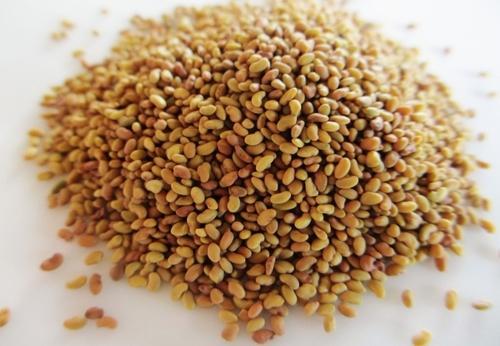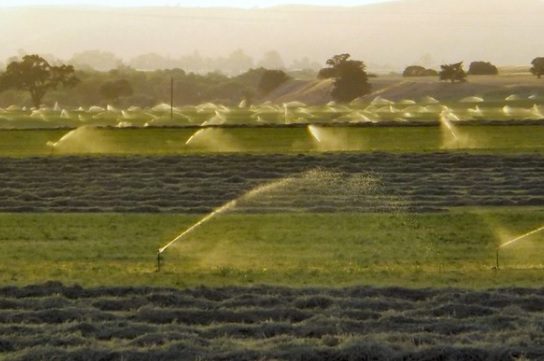Cultivation of Lucerne (Medicago sativa) or Alfalfa in India
Cultivation of Lucerne (Medicago sativa) or Alfalfa in India
Lucerne (Medicago sativa L.) or alfalfa belongs to the family Leguminosae and genus Medicago. It is a deep-rooted herbaceous annual as well as a perennial plant, growing up to a height of 60 to 150 centimeters It is one of the most important fodder crops in India. it is mainly grown in regions where the water supply is poor for Berseem. Being deep-rooted crop lucerne extracts water from the deeper one of the soil. It can be grown as a rainfed or unirrigated crop in high-water table areas.
The lucerne crop in India is mostly grown with irrigation in the state. of Punjab, Haryana, UP, Gujarat, Maharashtra, & T.N.
Nutritive Value of Lucerne or Alfalfa
Climatic Requirements for Lucerne or Alfalfa Crop;
Soil Requirements for Lucerne or Alfalfa Crop;
1) Lucerne can be grown on a wide range of soils, from sandy loam to clay.
Important Varieties of Lucerne
There are only a few good varieties of lucerne that could be grown successfully in most parts of the lucerne growing tracts. Characteristics of some of the important and most commonly grown varieties are given as follows:
|
Variety |
Characteristics |
|
Sirsa No-8 |
This is a variety of annual Lucerne evolved from Fodder Research Station, Sirsa in Haryana. It is suitable to grow in Punjab, Haryana, Delhi, and Uttar Pradesh. It has deep green foliage and violet flowers. This variety gives about 500 to 700 quintals of green fodder and 2 to 3 quintals of seed per hectare per year. |
|
Sirsa No.9 |
This is a variety of perennial lucerne which was also evolved from Fodder Research Station, Sirsa. It is a quick growing variety with deep green foliage, slender stalks, and bluish-purple flowers. It is suitable for growing in north India. It yields about 600 to 900 quintals of green fodder and 2.5 to 4.25 quintals of seed per hectare per year. |
|
NDRI Selection No-l |
It has thick roots which penetrate deep into the soil. It is a selection material obtained from Saurashtra and Kutch. The leaves are smaller in size with thin and turgid stems. The florets and the seeds are smaller in size when compared to other lucerne varieties. This variety of is capable of maintaining itself in its pure stands over five to years without getting degenerated to the infestation of weeds. The cr is ready for first cut after 60-70 days of sowing. It gives about 1000 quintals of green fodder per hectare per year. This variety once sown continues to Be green fodder for over 6 years. |
|
AL-3 |
The variety, Anand Lucerne-3 (AL-3) is recommended for Lucerne growing areas of Middle Gujarat. It yields nutritious and palatable fodder continuously for 2 to 3 years as well as it gives more herbage. It has good regeneration capacity and negligible incidence of pests and diseases. Yield potential 1000-1100 Qt/Ha |
|
AL-4 |
Perennial nature. Recommended for North west zone of India. Yield potential 800- 900 qt /Ha |
|
Chetak (S-244) |
The variety is suitable for cultivation in Punjab, Haryana, Uttar Pradesh and Gujarat. The plant height is 70–90 cm with dark green foliage and light purple flowers. It has quick regeneration capacity with resistance to aphids. It yields 140–150 t/ha green fodder. |
|
GAUL-2 (SS-627) |
It has been recommended for cultivation in whole Gujarat but has been found more suitable for northern Gujarat. The plants are tall and provide 10 to 12 cuttings in a year with 80–100 t/ha green fodder. |
|
GAUL-1 (Anand-2) |
selection from perennial type Lucerne grown in Bhuj area of Kutch region of Gujrat. The green forage yield is 80–100 t/ha. It is suitable for cultivation in Gujarat, Rajasthan and Madhya Pradesh. Yield is 70–80 t/ha green fodder in 10–12 cuts/ years and 0.2–0.3 t/ha seed. |
|
Composite 5 |
It gives 8 cutting up to first week of July and has a yield potential about 70–75 t/ha fodder and 0.3–0.5 t/ha seed. |
|
Composite 3 |
It is resistant to lodging and frost and provides 38–40 t/ha green fodder and 0.30–0.35 t/ha seed |
|
Lucerne no. 9-L |
It is a quick growing variety with deep green foliage, slender stalks and purple flowers. It grows well for a period of 5–7 years. Its yield potential is about 75 t/ha of green fodder/year. It yields 55–60 t/ha of green fodder up to July during the first year |
|
RL-88 |
The variety has been recommended for cultivation for year-round irrigated situations in all zones of the country. This first cut of the crop can be taken in 50–60 days of sowing and thereafter cut can be taken at 25–30 days. The variety is resistant to major diseases and pests and yields 75–100 t/ha green fodder in 11 cuts. |
Rotations and Mixed Cropping in Lucerne or Alfa-Alfa;
Lucerne is generally grown after harvesting Kharif crops such as jowar, paddy, maize, soybean, cowpea, guar, etc. It can be grown in Rome with almost every grain or forage crop. The common rotations are as follows:
1. Maize-lucerne
Note ;
Field Preparation for Lucerne or Alfa-Alfa Crop;
1) Lucerne needs a fine well-leveled seedbed with adequate moisture.
Seed and Sowing of Lucerne or Alfa-Alfa Crop;
Sowing Method;
1) Sowing may be done either by broadcast or line sowing method
2) The seed may be drilled in lines 20 centimeters apart with a seed drill or ‘pora’ attached with a local plough at the rate of 12-15 kg per hectare.
Manures and Fertilizers for Lucerne or Alfa-Alfa Crop;
1) Lucerne being a leguminous crop fulfills its major part of nitrogen requirement through the process of symbiotic nitrogen fixation which works effectively from three to four weeks after sowing.
5) Lucerne is a heavy feeder on soil nutrients. Some of the essential micronutrients such as boron, iron, zinc, manganese, etc., are also likely to become deficient in certain soils. Proper care should be taken to supply these nutrients in deficient soils.
9) Experiments have shown that placement of fertilizers at a depth of 4-5 centimeters gives 20-25 percent higher yields in lucerne than when broadcast and mixed in the soil.
Water Management Lucerne or Alfa-Alfa Crop;
1) To attain good germination, pre-sowing irrigation is essential.
Weed Control Lucerne or Alfa-Alfa Crop
1) Lucerne takes a long time to establish itself and gives ample scope for growth up to the time of the first cutting.
Diseases and Pest Management in Lucerne or Alfa-Alfa Crop;
a) Disease Management;
1) Bacterial Wilt;
It is the most serious disease of lucerne which is caused by Aplanobacter insidiosum. The growth of the infected plants gets stunted and there are a large number of branched stems. The roots of affected plants shows brownish-yellow discoloration of the woody tissue. The condition of the field gets worse when the crop gets older.
Control Measures;
(1) Grow resistant varieties.
2) Leaf Spot;
It is another severe and widespread disease of lucerne. It is caused by a fungus Pseudopeziza medicaginis. The spots are circular and dark brown to black in color. Diseased plants turn yellow and leaves drop off.
Control Measures;
(1) Early cutting can cure the crop to some extent.
b) Insect Pests;
1) Lucerne Weevil
The larvae of this pest feed on the leaves and in severe infestations cause stunted growth. This pest can be controlled by spraying 0.05% Endosulfan 35 EC.
2) Lucerne Caterpillar;
This is also another serious pest of lucerne. Pupae of this pest lives in Soil. The population could be controlled by hoeing in between the rows. In case of severe infestation spray of 0.2%, Sevin should be done.
3) Leaf Hoppers;
Leafhoppers of several species suck the sap of the leaves. Control is difficult because young wingless hoppers hide on the underside of leaves and the adults are quite resistant to insecticides.
Besides above mentioned main pests there are several other pests like aphids, green plant bugs, thrips, semi looper, etc., which damage the lucerne crop.
Care should be taken if insecticides are used for controlling pests. Do not feed the fodder to the animals for a period of 20-25 days after spray.
Seed Production of Alfa-Alfa or Lucerne;
1) For seed production, the crop is allowed to flower after taking a cutting at the end of January.
Harvesting of Lucerne or Alfa-Alfa;
The first cutting should be taken 50-60 days after sowing and the subsequent cuttings at the interval of 20 to 30 days when crop a height of 60 centimeters from the ground.
Yield;
A well-managed crop may yield 800 to 1000 quintals of green fodder and 1.75 to 2.5 quintals of seed per hectare.






Pingback: Cultivation of Hybrid Napier Grass for Cattle Feeds; A Full Guide of Information - Agrovista-Farming